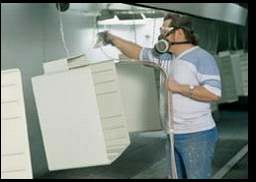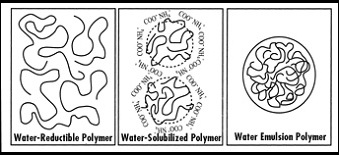Coating & Ink
Waterborne Coatings
All liquid coatings are comprised of four basic components: resins; pigments; solvents; and additives. These components determine the coating system’s final properties.
Waterborne coatings are coating systems in which water is the primary “solvent.”
Research into waterborne coatings began in the 1950s. Today, nearly four decades later, waterborne coatings have come into wide use.
For years, waterborne coatings were considered the weaker chemical cousins of solvent-borne systems. But, in recent years, prompted by stricter air quality regulations, coatings manufacturers have made the advancement of waterborne coatings a high priority. The result has been technological progress that has enabled the development of coatings that closely simulate the high-performance characteristics of solvent coatings while offering a number of key advantages.
Advantages
The most significant of these advantages may be low VOC levels, which enable waterborne coatings to satisfy even the most stringent regulations. Typically, waterborne coatings have VOC levels well below 2.0 lb/gal.

Because they are primarily reduced with water instead of solvents, waterborne coatings also offer soap and water clean up, which results in significant savings to finishers in solvent costs. Lower solvent levels, in most cases, also translates into lower odor for improved working conditions and reduced fire hazards, resulting in lower insurance premiums and greater worker safety.
Waterborne coatings may be applied to most substrates, including metal, plastic, wood, glass and masonry surfaces, using most types of application equipment, including spray, dip or flow coating. Some waterborne coatings may be air-dried while others require baking.
Disadvantages
Waterborne coatings are not appropriate for every application. The coatings work best up to 1.2 mil dry film thickness. Where humidity is high, waterborne coatings take longer to dry, so air circulation, exhaust or dehydration systems may be needed. They also may be more expensive than other types of coating systems.
Types of Waterborne Coatings
Though not completely solvent-free, waterborne coatings contain very low levels of organic solvents. The coatings cure in much the same way as solvent-borne systems, either through oxidative or thermosetting cross linking reactions. Latex waterborne coatings cure through latex coalescence, which occurs when both water and solvents evaporate with the resulting pressures causing the latex particles in the coating to coalesce.

Most of the waterborne coatings in use today contain one of three types of synthetic polymers, which largely determine the coating’s final properties: water-emulsion, aqueous dispersion or emulsion polymers; water-soluble or colloidal dispersion poly-mers; or water-reducible resins. These three types of polymers differ significantly in physical and mechanical properties, allowing the formulator considerable latitude in developing waterborne coating systems. (See Figure 1)
Depending on the resin system and coating formulation, a full spectrum of chemical and physical performance properties can be achieved. For example, waterborne coatings can possess good to excellent properties such as hardness, stain resistance, flexibility and corrosion resistance. They also can have high gloss and excellent solvent and humidity resistance.
Water-Emulsion Coatings. Water-emul-sion coatings contain emulsion polymers, which are discrete spherical particles of high molecular weight dispersed in water. The polymer particles are separate from the water, making it possible to raise the molecular weight of the polymers to achieve improved performance properties without affecting viscosity.
Because of this molecular weight advantage, emulsion polymers offer the greatest toughness, chemical and water resistance of the three types of waterborne coatings. With force drying, pencil hardnesses of 2H to 3H may be achieved. Water-emulsion coatings also allow the highest application solids.
In recent years, the development of high-performance emulsion resins have made possible some major advances in water-emulsion technology. Also, improved monomer selection and refinements in the control of molecular weights have helped to improve waterborne coating systems. Refinements in water-emulsion systems are improving adhesion to new plastics.
Water-emulsion coatings can be air-dried, or a thermosetting reaction may be introduced for improved solvent and chemical resistance and, in some cases added toughness that cannot be achieved by increasing molecular weight alone. These coatings are increasingly being used for higher performance applications, particularly in the finishing, automotive plastics and business machines markets.
Water-Soluble Coatings. Water-soluble coatings contain spherical particles dispersed in water. The particles are smaller than water-emulsion particles and swell in water, therefore molecular weight is between that of emulsion polymers and true solutions. The particles, called colloidal dispersion polymers, have polar groups, either acidic or basic, which impart a degree of solubility.
Colloidal dispersion polymers can be considered hybrids of emulsion and solution polymers because they exhibit characteristics of both types. The resulting water-soluble coatings may offer good gloss, toughness, water and chemical resistance properties and good durability as well as ease of application. Water-soluble coatings are most commonly used for many industrial finishing applications.
Water-Reducible Coatings. Water-reducible coatings contain copolymers formed by polymerization reactions that occur in water-miscible organic solvents such as alcohols or esters. Polar groups on the polymer allow water-reducibility, forming true solutions of polymer in water. Unlike water-emulsion polymers, the viscosity and properties of these coatings are largely dependent on molecular weight.
Water-reducible coatings may offer high gloss, clarity, depth of image, good pigment wetting and dispersion and good application properties. Water-reducible coatings are most commonly used for general industrial and finishing applications. New resins are resulting in enhanced corrosion resistance for finishing applications.
Resin Types
Alkyd, acrylic latex, epoxy, acrylic/epoxy hybrid, polyurethane, polyester and other resins may be used in the formulation of waterborne coatings. For general finishing applications, alkyd coatings are commonly used. Acrylics also are frequently selected for finishing applications. Water-soluble epoxy esters and alkyds dominate the automotive components area.
Water-reducible epoxies are most often used as primers that can be topcoated with most other coatings. Frequently, water-reducible epoxy primers are topcoated with polyurethanes when good corrosion resistance and high-performance properties are required.
In the future, continued advances in waterborne technology are expected to produce ever-superior coating systems. Developments in waterborne products can be expected to continue to improve application and performance characteristics, providing finishers with an effective and important solution to the challenge of VOC compliance.
By Dan Lescarbeau - Cleveland, OH



